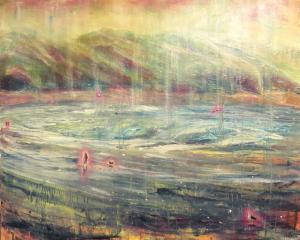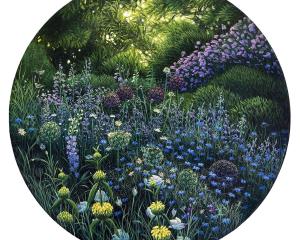
Sam Foley feels he needs to know the landscape before he can paint it properly, so he tends to live in a place for a while before he does a series of works on it.
His coming exhibition, ''Harbour'', which opens a week tomorrow, is a result of living in Port Chalmers for a time, he says.
''It was an area I know quite intimately having grown up in West Harbour. I always wanted to do a painting of the bottom intersection because it's perfect for what I'm doing with moving images.''
He grew up in St Leonards and had a friend who lived next door to Ralph Hotere's studio in the former BNZ building.
''As a young teenager I used to visit next door and hear about him, someone called an artist, and we'd try and peer in the window and see what was going on. It was a bit of a mystery. I think that is certainly why the place has resonated for me.''
This painting of the Port Chalmers intersection at night has a cleverly matched video image imposed on it, showing vehicles - cars, buses, trucks, moving ghost-like across the canvas, and shadows of pedestrians moving through the lit areas before disappearing into the dark.
From that painting of the intersection, the rest of his body of work for this exhibition on Otago Harbour developed, he said.
As this is his 20th solo exhibition, he is also producing a book that he describes as a step up from a catalogue, with an essay by James Dignan and images of the 12 works.
Foley (37) says becoming an artist was a natural progression.
Doing well in art and related subjects at Logan Park High School encouraged him to continue on to art school and then to choose to be a freelance artist rather than follow the easier - as far as money goes - career of design, he said.
''For me it's the dream job. You are your own boss, you get to do what you want which is a really nice thing - you can't forget that side of it.''
Although the first five years out of art school were difficult, with the support of the then Labour government's Pace (Pathways to arts and cultural employment) scheme he managed to survive and for the past decade has been a fulltime artist.
''I certainly scratch a reasonable living now,'' he said.
His large detailed photorealist oil landscapes, many of them nightscapes, sell for between $10,000 and $12,000, and take him more than 100 hours.
The current exhibition of 12 paintings took 18 months to complete.
He loves the challenge of painting landscapes.
As a child he remembers seeing Petrus van der Velden's large painting of the waterfall in the Otira Gorge in the old Dunedin Public Art Gallery at Logan Park.
He was blown away by it and has since done a series of paintings of the area, a homage to van der Velden, he said.
He also enjoys the challenge of chiaroscuro, an Italian term that refers to the tonal difference between light and dark, which is why he often paints outdoor night scenes with bright patches illuminated by street lights.
A breakthrough in this was his Greenbelt series of night scenes in the town belt in 2005, he said.
''People, especially Dunedinites, had a real affiliation with that. Maybe it was something they had seen a lot but hadn't seen it presented as an iconic image as such. That was a result of me living in the area and doing a lot of night walking.''
The night works have a limited palette but more tonal variation.
When something is too black to show tonal details he uses paint texture, often applying it thickly then scraping it off with various tools to render detail.
He works from photographs taken with a wide-angle lens, cropping them, occasionally moving an object slightly, but mostly staying true to the image.
For the night works he takes an overexposed image to get the detail and an underexposed one to get the light effects.
He visits a place three, four or five times over at least a couple of weeks to get a feeling for it and an image he is happy with, but selection of a scene to paint is instinctual.
''I'll see something and think that needs to be painted and I just plunge headfirst into it. I tend not to overthink images. Obviously I'll get a basic idea for a theme and run with it.''
He has lived and worked in other places.
Last year an exhibition in Tauranga, where his grandparents live, featured Mt Maunganui.
He has also spent a couple of seasons in Berlin and a recent residency in Solothurn in Switzerland, the result of winning the Kaipara Foundation Wallace art award last year.
He plans to return to Switzerland next year, but before that he has an exhibition at Pataka in Porirua and will be going north in February to source material, he said ''I feel my work is going to take an industrial turn. I'm interested in what happens to old commercial spaces and industrial spaces.''
His studio is one of several artists' studios in a former industrial space that was once Hallenstein's factory on the third floor of a Dowling St building.
This is where his exhibition, ''Harbour'', will open before moving down the road to The Artist's Room.









![Poipoia te Kākano [installation view]. Allison Beck, Megan Brady, Kate Stevens West, Jess...](https://www.odt.co.nz/sites/default/files/styles/odt_landscape_small_related_stories/public/story/2025/02/1_poipoia_te_k_kano.jpg?itok=ssJ8nxyx)


